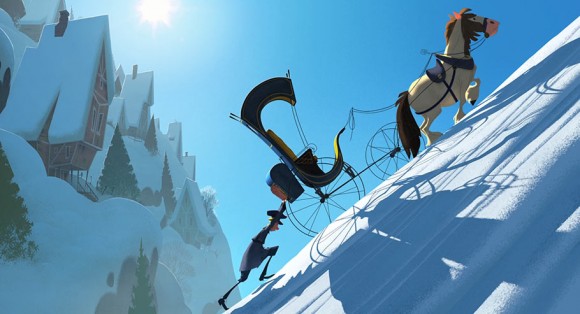

Sergio Pablos Talks About His Stunning Hand-Drawn Project ‘Klaus’ [Exclusive]
Animator and director Sergio Pablos has unveiled the breathtaking teaser for his hand-drawn project Klaus:
No, that’s not a typo: hand-drawn.
You could be forgiven for thinking the character animation was modeled and animated with CGI software because Klaus has the polished sheen of the latest big-budget studio CGI epic. But watch again, and the enduring organic charm of hand-drawn animation is evident throughout.
Pablos, of course, knows a thing or two about drawn animation. An accomplished animation master who participated in the 1990s Disney renaissance, he animated on films such as The Hunchback of Notre Dame and Hercules, before supervising Tantor in Tarzan and Dr. Doppler in Treasure Planet.
After the hand-drawn feature animation industry collapsed stateside, he moved back to his home country of Spain where he launched his own company Animagic (today, known as SPA Studios). His company has racked up an impressive list of credits, providing pre-production and production support to feature productions, but Pablos’s biggest claim to fame is originating the concept for the blockbuster Illumination franchise Despicable Me.
With Klaus, Sergio Pablos has created a potential game-changer by applying the latest digital technology to a traditional approach, and, in the process, redefining what a hand-drawn feature could look like. Pablos is keeping his proprietary process under wraps for the moment—the project is still in active development and seeking financing—but he corresponded exclusively with Cartoon Brew via email over the weekend to fill in other details about the project.

CARTOON BREW: Tell me a little bit about the background of Klaus. How did the project start?
SERGIO PABLOS: Well, you may be aware that I’ve spent the last few years developing and participating in CGI feature films. I have no complaints there: it’s been a blast and I’m very grateful for everything I learned. Seeing Despicable Me grow into what it is today has been a true joy and one of my proudest achievements.
But like many of us, I miss the freedom and spontaneity of traditional animation. Don’t get me wrong, I love CGI when it’s well made. But there’s no denying that there’s a unique quality to hand-crafted animation when done by a great artist.
So I asked myself, What would a traditionally animated film have to be to be relevant today? I resolved that it came down to two things: visually, we had to move the medium forward instead of taking refuge in nostalgia; and, from a narrative point of view, we had to open up to other kinds of stories: as a matter of fact, it was precisely about finding the kind of story that would benefit from the traditional medium. From this exercise, Klaus was born.

CARTOON BREW: You released the teaser today. What stage is the project at?
SERGIO PABLOS: We’ve been lucky enough to find support to complete development and are currently seeking investing, co-production, and distribution partners.
CARTOON BREW: Disney, among other studios, has been exploring the use of non-photorealistic rendering CGI styles with Paperman and Feast. You’ve come at it from the other side—giving hand-drawn animation the smoothness and volume of a CGI production yet with mouth shapes and other elements that retain a distinctly hand-drawn feel. What do you see as the benefits, both artistic or commercial, of pushing hand-drawn animation into a space where it more closely resembles CG?
SERGIO PABLOS: Here’s how I look at it: What we set off to do was to overcome some of the technical limitations that traditional animation had. We focused on organic, volumetric lighting, and texturing. If the end result ends up looking to some like CGI, that’s an unintentional side effect. The goal was to develop tools that eventually allowed us to put any visual development style on the screen. It seems like most films’ looks are very standardized, and we’re hoping to overcome that way of thinking. We’re just getting started, but the possibilities are very exciting. And, if your intention is to put something that feels hand-crafted on the screen, there’s no shorter path than starting from a hand-crafted medium.

CARTOON BREW: How much more complicated is the pipeline to produce this type of animation compared to a standard hand-drawn film, and what kind of budget is required?
SERGIO PABLOS: Well, we’re obviously adding a couple of items to the 2D pipeline. But then, the standard 2D pipeline is much simpler than that of a mainstream CGI film. Also, the next stage of R&D will focus on improving the tools and optimizing the process, so I’m fairly certain that it will be a pretty small impact by the time we’re done.
CARTOON BREW: Can you talk about your approach/process to lighting and texturing the piece and the type of challenges presented to achieve this look?
SERGIO PABLOS: I can’t go into too much detail, but I can tell you that no geometry is involved, that the end result depends greatly on the artistic ability of the creators, and that it mostly takes place during the later stages of production, which means that it does not affect the way in which traditional animators work.
CARTOON BREW: How many animators were involved in making the piece? And do you (and others at your studio) still animate on paper or do you draw everything digitally?
SERGIO PABLOS: We had some friends around the world chip in with a few shots, but it’s mostly the work on two animators. Most of the animation was done digitally on TVPaint.
To learn more about Klaus and SPA Studios, make sure to attend Pablos’s talk at Annecy later this month.


